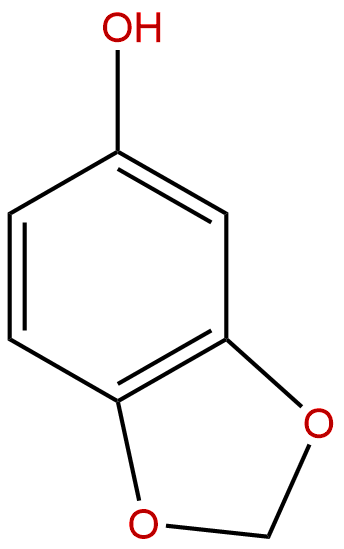
SesamolCAS No.:533-31-3
|
||||||||||
 |
|
|
||||||||

| Catalogue No.: | BP1297 |
| Formula: | C7H6O3 |
| Mol Weight: | 138.122 |
Synonym name: 1,3-Benzodioxol-5-ol, 9CI; 1,2,4-Benzenetriol methylene ether
Catalogue No.: BP1297
Cas No.: 533-31-3
Formula: C7H6O3
Mol Weight: 138.122
Botanical Source: sesame oil (Sesamum indicum)
Purity: 95%~99%
Analysis Method: HPLC-DAD or/and HPLC-ELSD
Identification Method: Mass, NMR
Packing: Brown vial or HDPE plastic bottle
Can be supplied from milligrams to grams.
For Reference Standard and R&D, Not for Human Use Directly.
Inquire for bulk scale.
Description:
Sesamol is regarded as a major antioxidant component in the oil with chemoprevention, radioprotective efficacy, anti-antiinflammary, antimutagenic, and antihepatotoxic activities. Sesamol inhibits melanin biosynthesis by down-regulating tyrosinase activity and melanin production via regulation of gene expression of melanogenesis-related proteins through modulation of MITF activity, which promotes phosphorylation of p38 and JNK in melan-a cells.
References:
Exp Dermatol. 2015 May 23.
Sesamol decreases melanin biosynthesis in melanocyte cells and zebrafish: Possible involvement of MITF via the intracellular cAMP and p38/ JNK signaling pathways¶.
The aim of this study was to investigate the anti-melanogenic effect of Sesamol, an active lignan isolated from Sesamum indicum, in melan-a cells.
METHODS AND RESULTS:
Sesamol strongly inhibited melanin biosynthesis and the activity of intracellular tyrosinase by decreasing cyclic adenosine monophosphate (cAMP) accumulation. Sesamol significantly decreased the expression of melanogenesis-related genes, such as tyrosinase, tyrosinase-related protein-1,2 (TRP-1,2), microphthalmia-associated transcription factor (MITF), and melanocortin 1 receptor (MC1R). In addition, Sesamol also induces phosphorylation of p38 mitogen-activated protein kinase (p38 MAPK) and c-Jun N-terminal kinase (JNK). Moreover, Sesamol dose-dependently decreased zebrafish pigment formation, tyrosinase activity, and expression of melanogenesis-related genes. These findings indicate that Sesamol inhibited melanin biosynthesis by down-regulating tyrosinase activity and melanin production via regulation of gene expression of melanogenesis-related proteins through modulation of MITF activity, which promoted phosphorylation of p38 and JNK in melan-a cells.
CONCLUSIONS:
Together, these results suggest that Sesamol strongly inhibits melanin biosynthesis, and therefore Sesamol represents a new skin-whitening agent for use in cosmetics. This article is protected by copyright. All rights reserved.
J Thromb Thrombolysis. 2014 Oct;38(3):321-30.
Crocin prevents sesamol-induced oxidative stress and apoptosis in human platelets.
Recent studies have reported the platelet proapoptotic propensity of plant-derived molecules such as, resveratrol, thymoquinone, andrographolide and gossypol. Meanwhile, there were also reports of phytochemicals such as cinnamtannin B1, which shows antiapoptotic effect towards platelets. Platelets are mainly involved in hemostasis, thrombosis and wound healing. However, altered platelet functions can have serious pathological outcomes that include cardiovascular diseases. Platelets are sensitive to external and internal stimuli including therapeutic and dietary components. The anuclear platelets do undergo apoptosis via mitochondrial pathway. However, exaggerated rate of platelet apoptosis could lead to thrombocytopenia and other bleeding disorders.
METHODS AND RESULTS:
The present study deals with ameliorative efficacy of crocin on Sesamol-induced platelet apoptosis. The antiapoptotic property of crocin and the proapoptotic tendency of Sesamol in platelets were previously demonstrated. Therefore, it was interesting to see how these two compounds would interact and wield their effects on human platelets. Crocin effectively inhibited Sesamol-induced oxidative stress on platelets, which was evidenced by the measurement of endogenously generated reactive oxygen species, particularly hydrogen peroxide, and changes in thiol levels. Further, crocin abrogated Sesamol-induced biochemical events of apoptosis in platelets, which include intracellular calcium mobilization, changes in mitochondrial membrane integrity, cytochrome c release, caspase activity and phosphatidylserine externalization. Even though Sesamol has proapoptotic effects on platelets, its anti-platelet activity cannot be neglected.
CONCLUSIONS:
Thus, the study proposes that Sesamol could be supplemented with crocin, an approach that could not only abolish the toxic effects of Sesamol on platelets, but also enhance the quality of treatment due to their synergistic action.
Mutagenesis. 2015 Sep;30(5):651-61.
Sesamol attenuates genotoxicity in bone marrow cells of whole-body γ-irradiated mice.
Ionising radiation causes free radical-mediated damage in cellular DNA. This damage is manifested as chromosomal aberrations and micronuclei (MN) in proliferating cells. Sesamol, present in sesame seeds, has the potential to scavenge free radicals; therefore, it can reduce radiation-induced cytogenetic damage in cells. The aim of this study was to investigate the radioprotective potential of Sesamol in bone marrow cells of mice and related haematopoietic system against radiation-induced genotoxicity.
METHODS AND RESULTS:
A comparative study with melatonin was designed for assessing the radioprotective potential of Sesamol. C57BL/6 mice were administered intraperitoneally with either Sesamol or melatonin (10 and 20mg/kg body weight) 30 min prior to 2-Gy whole-body irradiation (WBI) and sacrificed after 24h. Total chromosomal aberrations (TCA), MN and cell cycle analyses were performed using bone marrow cells. The comet assay was performed on bone marrow cells, splenocytes and lymphocytes. Blood was drawn to study haematological parameters. Prophylactic doses of Sesamol (10 and 20mg/kg) in irradiated mice reduced TCA and micronucleated polychromatic erythrocyte frequency in bone marrow cells by 57% and 50%, respectively, in comparison with radiation-only groups. Sesamol-reduced radiation-induced apoptosis and facilitated cell proliferation. In the comet assay, Sesamol (20mg/kg) treatment reduced radiation-induced comets (% DNA in tail) compared with radiation only (P < 0.05). Sesamol also increased granulocyte populations in peripheral blood similar to melatonin. Overall, the radioprotective efficacy of Sesamol was found to be similar to that of melatonin. Sesamol treatment also showed recovery of relative spleen weight at 24h of WBI.
CONCLUSIONS:
The results strongly suggest the radioprotective efficacy of Sesamol in the haematopoietic system of mice.